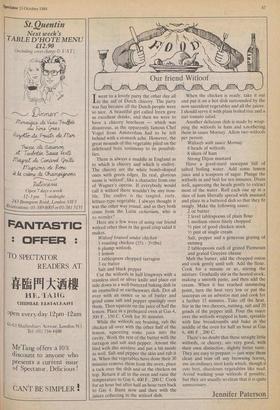Our friend Witloof
j went to a lovely party the other day all in the aid of Dutch chicory. The party was fun because all the Dutch people were so nice. A beautiful girl called Ireen gave us excellent drinks, and then we were to have a chicory luncheon — which was disastrous, as the apparently famous Chef Vogel from Amsterdam had to be left behind with a stomach ache. However, the great mounds of this vegetable piled on the sideboard bore testimony to its possibili- ties.
There is always a muddle in England as to which is chicory and which is endive. The chicory are the white bomb-shaped ones with green edges. Its real, glorious name is *Woof , like a character from one of Wagner's operas. If everybody would call it witloof there wouldn't be any trou- ble. The endive is the tangled, curly, lettuce-type vegetable. I always thought it was the other way round, and as they both come from the Latin cichorium, who is to wonder?
Here are a few ways of using our friend witloof other than in the good crisp salad it makes.
Witloof braised under chicken 1 roasting chicken (21/2 - 31/2Ibs) 6 plump witloofs
1 lemon 1 tablespoon chopped tarragon
3 oz butter Salt and black pepper
Cut the witloofs in half longways with a 'stainless steel or silver knife and place cut side down in a well-buttered baking dish Or an enamelled or earthenware dish. Dot all over with an ounce or so of butter and grind some salt and pepper sparingly over them. Then squeeze on the juice of half the lemon. Place in a preheated oven at Gas 4, 300 F., 150 C. Cook for 30 minutes.
While the witloofs are braising, rub the chicken all over with the other half of the lemon, squeezing some juice into the cavity. Work the rest of the butter with the tarragon and salt and pepper. Anoint the bird with this mixture and put a bit inside as well. Salt and pepper the skin and rub it in. When the vegetables have done their 30 'minutes remove them from the oven, place a rack over the dish and sit the chicken on top. Return it all to the oven and raise the temperature to Gas 6, 400 F., 200 C. Cook for an hour but after half an hour turn back to Gas 4. Baste now and then with the juices collecting in the witloof dish. When the chicken is ready, take it out and put it on a hot dish surrounded by the now succulent vegetables and all the juices. I should serve it with plain boiled rice and a tart tomato salad.
Another delicious dish is made by wrap- ping the witloofs in ham and smothering them in sauce Mornay. Allow two witloofs per person.
Witloofs with sauce Mornay
8 heads of witloofs 8 slices of ham Strong Dijon mustard Have a good-sized saucepan full of salted boiling water. Add some lemon juice and a teaspoon of sugar. Plunge the witloofs in and boil for ten minutes. Drain well, squeezing the heads gently to extract most of the water. Roll each one up in a slice of ham liberally spread with mustard and place in a buttered dish so that they fit snugly. Make the following sauce: 2 oz butter 2 level tablespoons of plain flour 1 medium onion finely chopped 1/2 pint of good chicken stock 1/2 pint of single cream Salt, pepper and a generous grating of nutmeg 2 tablespoons each of grated Parmesan and grated Gruyere cheese Melt the butter, add the chopped onion and cook gently until soft. Add the flour. Cook for a minute or so, stirring the mixture. Gradually stir in the heated stock, making a smooth paste, and then add the cream. When it has reached simmering point, turn the heat very low or put the saucepan on an asbestos mat and cook for a further 15 minutes. Take off the heat. Stir in the two cheeses, nutmeg, salt and 20 grinds of the pepper mill. Pour the sauce over the witloofs wrapped in ham, sprinkle with fine breadcrumbs and bake in the middle of the oven for half an hour at Gas 6, 400 F., 200 C.
There's no doubt that these straight little witloofs, or chicory, are very good, with their own distinctive, slightly bitter taste. They are easy to prepare — just wipe them clean and trim off any browning leaves, use an ordinary steel knife which, though it cuts best, discolours vegetables like mad. Avoid washing your witloofs if possible, but they are usually so clean that it is quite unnecessary.
Jennifer Paterson






















































 Previous page
Previous page